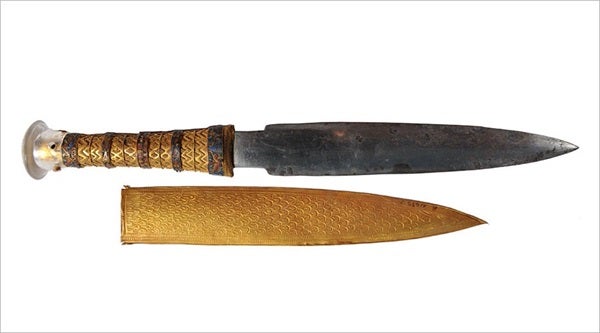Those were Howard Carter’s words when he looked into the newly opened tomb of King Tutankhamun in 1922. What he saw was astounding: “Strange animals, statues, and gold — everywhere the glint of gold.”
And within the wrappings of the entombed mummy, there to serve the young ruler during his journey into the afterlife, was a dagger. The dagger’s handle, topped by a crystal pommel, was intricately crafted gold. But the most remarkable part of the dagger was the 13-inch blade itself. Largely untarnished in the 3,200 years since Tut’s death, the blade was expertly worked from a metal that Egyptians would not begin to smelt for another half a millennium: iron.
It wasn’t until 2016 that a team led by Daniela Comelli of the Department of Physics at the Polytechnic University of Milan finally put the question of the blade’s provenance to rest. High concentrations of nickel and traces of cobalt left no doubt — the blade was made of iron from a meteorite.
Egyptian artifacts made from meteoritic iron date back 2,000 years before Tutankhamun, and early Egyptian texts use the term for iron to refer to some aspects of the sky. But around Tutankhamun’s time, a new word appeared. Translated literally, the rare metal was now, “iron from the sky.” As have so many civilizations, Dynastic Egyptians imagined gods and goddesses living in the heavens. A rock falling from the sky was a magical gift, fit indeed for the afterlife of a king.
Vast amounts of knowledge were lost with the decline of the ancient world. Medieval Europeans concerned themselves little with such things, until the reawakening of intellectual curiosity that began the Age of Reason. Then, in part inspired by several well-observed meteorite falls in the closing years of the 18th century, a new generation of scientists turned their attention to the strange phenomenon.
Antoine Lavoisier, the great French chemist known for his many contributions to science, including the discovery of oxygen and the explanation of the process of combustion, wasn’t having any of it. “A stone cannot fall from the sky,” Lavoisier said. “There are no stones in the sky!”
Lavoisier might have changed his mind had he gotten the chance to study meteorites firsthand, but fate and politics intervened. Intellectuals are often among the victims of zealotry; the French Reign of Terror was no exception. Lavoisier was put to the guillotine in May 1794, nine months after the government suppressed all learned societies in France. (It took the Catholic Church more than 350 years to absolve Galileo of heresy; Lavoisier was exonerated only a year and a half after his execution. Both were Pyrrhic victories at best.)
Fortunately, intellectuals on the west side of the Atlantic were faring better at the time. Thomas Jefferson, an amateur scientist in his own right, was among those perplexed by meteorites and more than a little skeptical. In a letter to Daniel Salmon following a fall in Weston, Connecticut, in 1807, Jefferson wrote: “It may be very difficult to explain how the stone you possess came into the position in which it was found. But is it easier to explain how it got into the clouds from whence it is supposed to have fallen?”
Yet as can happen so easily at the birth of a new science, Jefferson himself was already behind the times. In 1794, the German physicist Ernst Chladni, known as the father of acoustics, had published his own ideas about meteorites. He linked meteorites and fireballs, and concluded that meteorites do fall from the sky. Chladni speculated that, given their extraordinary speed, meteorites originated not only from space, but from interstellar space. While the final suggestion was off the mark, Chladni lived to see the first two of his ideas come to be accepted by the scientific community.
The modern science of meteoritics gathered steam in the 19th century as scientists began to classify meteorites and study their compositions. With the birth of nuclear physics, meteorites became key to understanding the age and early history of the solar system. Using spectroscopy and dynamics, astronomers connected meteorites with the asteroids from which they arose. Today, meteoritics is key to theories about the processes that began in the interiors of stars and ultimately gave birth to our home world.
We’ve come a long way since ancient Egyptians hammered ceremonial daggers out of strange, heavenly metal, or Europeans spoke of thunderstones.











